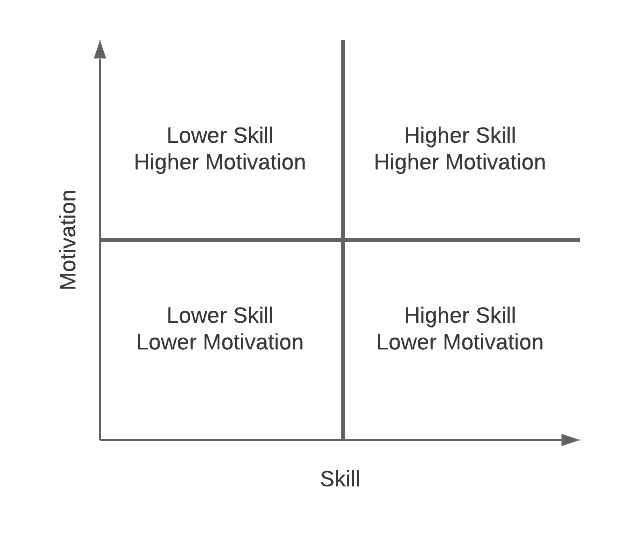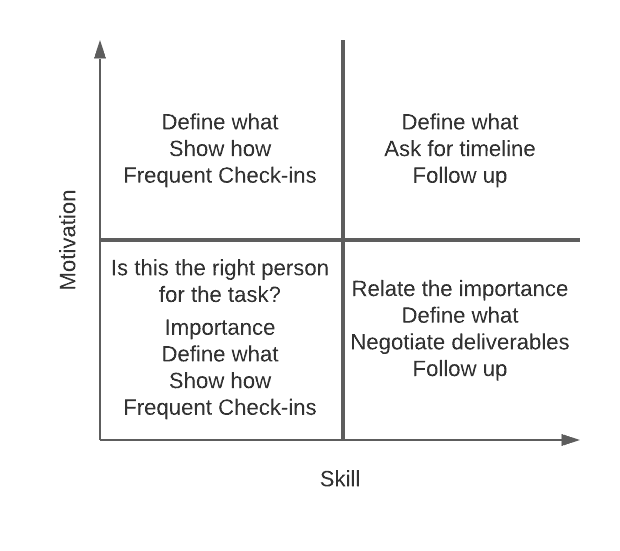When you are a leader of people, knowing the best approach for delegating assignments to a given person for any given objective is key to not only good outcomes but also to learning and growth. One good way to tailor your leadership style to each person and scenario is to use the skill-motivation matrix. This tool allows you to differentiate the delegation approach given skill and motivation of the person. I use this tool myself and teach it to rising managers and executive leaders. It’s simple to apply and can have a profound impact on your ability to grow the folks on your team while vastly improving outcomes, productivity, and satisfaction. It works well for high-level goals as well as specific tasks.
The first step is to recognize that each individual will have their own level of skill and their own level of motivation for any given objective or task. For example, an entry-level software engineer may have an energetic level of motivation to do engineering, but not the experience or skill to tackle complex problems on their own. On the other hand, a senior cloud architect who is highly skilled in solving systems engineering problems is likely not too motivated to fix that labeling error in the product user interface. These are just two examples that represent extreme corners of our matrix.
While the skill-motivation matrix in fact a 2-dimensional continuum, it can be thought of as a set of quadrants as shown in the figure below.
Our entry-level engineer is somewhere in the top left quadrant, while our senior cloud architect might be in the lower right. If we try to lead these two in the same way, we will likely be disappointed by the results. So, we as leaders need to adapt our approach and our style to the unique person and scenario at hand. By understanding where someone falls on the Skill-Motivation matrix, we know how to appropriately adapt and approach the situation.
I break it down into the Why, What, When, and How. Each of these carries different significance for each situation. The figure below depicts our matrix with what we leaders need to focus on for each quadrant.
Let’s take a deeper look into each quadrant. I’m not going to spend any time exploring the “What” aspect of things, it’s present in all quadrants. Obviously you need to define what needs to be accomplished when delegating any task. Follow-up is also important across all the quadrants, if you ask someone to do something, and then never follow-up, they will doubt that you cared or truly needed it done.
We’ll focus on the whys, whens, and hows in the discussion below.
Lower Skill – Lower Motivation (the No-Go Zone)
When you find yourself delegating something to someone that has lower skill for the job, and low motivation to do it, you need to first ask yourself if this is the right person for the job. Sometimes you don’t have a choice, but I generally think of this as the no-go zone because it involves working against the tide on both fronts. You are essentially asking someone to do something they don’t know how to do, and don’t want to do. Kinda like getting a young teenager to do their own laundry. OK, not a great example because the teen needs to learn this to be successful at adulting but anyone with kids can certainly relate.
WHY: If you do end up having to delegate in this situation, you’ve got to start with why the task is important. Perhaps you can help move the motivation up a bit by relating how the task advances some important goal or contributes to the organization’s success. You’ve got to be genuine here, people can detect BS no matter how you dress it up.
HOW: You are going to have to show this person how to do the task, perhaps even doing it alongside them and guiding them through it step by step. At a minimum you are going to need to be available and responsive to questions, issues, and feedback. If you don’t know how to do it yourself (ahem, this matrix applies to you too), perhaps you need to find another person for this task.
WHEN: Ask the person what else they have on their todo list and when they think this could be done. You’ll need to let them know where this task lands among those other priorities. Likely they won’t be able to answer the second part, since they don’t know how to do it. Frequent check-ins will be required so you can make sure they are making progress. People in this zone will tend to silently stall or fail so you as the leader will need to be proactive.
Lower Skill – Higher Motivation (the Growth Zone)
Often, delegating into this zone occurs when you have a team member that is learning new skills or growing into a new role.
WHY: You don’t need to spend a lot of time on why the task is important here, the person is already motivated to work it and get things done. That said, I believe that relating the need and importance of a task is always useful. It provides a sense of contribution to the person doing the task and a bigger picture context that could inform their approach or even the shape of the deliverable.
HOW: Here again, you are going to need to show this person how to do the task or provide them a checklist, and be available to them for questions. There is a key difference from the No-Go Zone however- the person is motivated and so will likely reach out proactively to their own resources (colleagues, google, etc) where the low motivated/low skilled person would stall out.
WHEN: Here we have a similar scenario as the No-Go Zone, but with another key difference. Your delegate is likely to be over-optimistic about their ability to get this done, so you’ll need to use your own experience with similar shaped tasks and help them understand how big/small/simple/complex it is. You still need to check-in frequently, but this to make sure the person is on track vs. down a rabbit hole instead of making sure the task is getting done.
Higher Skill – Lower Motivation (the Engagement Zone)
The challenge for delegating into this quadrant is getting engagement from the delegate. They know how to do it, perhaps even easily- they just don’t want to be the one to have to do whatever it is.
WHY: This is the most important variable in this scene. You’ve got to relate to the person not only why the task is important, but also why you are tasking them (vs some other unlucky soul) to do it. Here again you’ve got to be genuine. This person needs to understand both why the task is important, and why it’s important that they are the one to do it. If you try to fudge it, you’ll not only end up lowering their engagement, but you’ll also lose their respect as a leader. So leave the butter-up lingo at home and be direct. If the person has the best skill to get it done fastest and time is of the essence, say so, but don’t be schmoozie about it.
HOW: This person knows how to get it done, don’t belittle them or patronize them by second guessing their approach. It’s fine to ask them what their approach will be to make sure it fits in a broader picture, but don’t micro-manage the work you are delegating. Get agreement on what the deliverables will be, make sure they have the resources required, and get out of the way.
WHEN: Ask them when they can get it done. If the answer doesn’t meet your needs or expectations, ask what else they are working on and help them put this in the right priority order on their backlog of tasks. This will likely take the form of a negotiation and you might have to give a bit on your ideal timeline. If you force this to a priority interrupt, it better be that critical- otherwise give them some control of the timeline. This will help with the motivation dimension as well.
Higher Skill – Higher Motivation (the Happy Place)
This is by far the easiest type of delegation. You’ve got someone to do the task that knows how to do it, and wants to do it. It’s almost a set and forget scenario (but it’s not).
WHY: As always, I think it’s a good idea to relate why something is important. In this case, the person is already motivated so this is more about context setting and letting them know they are being asked to do meaningful work. That will count for ongoing engagement.
HOW: Like the previous quadrant, your delegate knows what to do. Make sure everyone agrees on the desired outcomes and deliverables, they have what they need, and let them do it.
WHEN: This person is motivated to do this and knows how to do it, so give them some relative priority for this and ask them when they can get to it and when it will be done. You may need to negotiate a bit if they have a lot on their plate already, but you won’t have to push them.
The next time you have an important task to delegate, try using this matrix and see how it makes a difference for the delegation itself, the engagement of the delegate, and the results you get back. I’d love to hear from you after you give it try on how things went.

